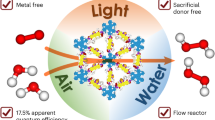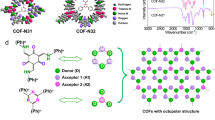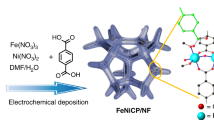Abstract
Enzymes have evolved to catalyse challenging chemical transformations with high efficiency and selectivity. Although a number of artificial systems have been developed to recapitulate the catalytic activity of natural enzymes, they are mostly limited to catalysing relatively simple reactions owing to their ability to mimic only the active metal centres of natural enzymes, without incorporating the proximal amino acids or cofactors. Here we report a metal–organic framework-based artificial enzyme (metal–organic–zyme, MOZ) by integrating active metal centres, proximal amino acids and other cofactors into a tunable metal–organic framework monolayer. We design two libraries of MOZs to perform photocatalytic CO2 reduction and water oxidation reactions. Through tuning the incorporated amino acids in the MOZs, we systematically optimize the activity and selectivity of these libraries. Combining these optimized MOZs into a single system realizes complete artificial photosynthesis in the reaction of (1 + n)CO2 + 2H2O → CH4 + nCO + (2 + n/2)O2.

This is a preview of subscription content, access via your institution
Access options
Access Nature and 54 other Nature Portfolio journals
Get Nature+, our best-value online-access subscription
$29.99 / 30 days
cancel any time
Subscribe to this journal
Receive 12 digital issues and online access to articles
$119.00 per year
only $9.92 per issue
Buy this article
- Purchase on Springer Link
- Instant access to full article PDF
Prices may be subject to local taxes which are calculated during checkout






Similar content being viewed by others
Data availability
Data relating to the characterization data of materials, detection of products, mechanistic studies, computational studies and NMR spectra are available in the Supplementary Information. Crystallographic data for the structures reported in this article have been deposited at the Cambridge Crystallographic Data Centre, under deposition numbers CCDC 2000080 (Ur). Copies of the data can be obtained free of charge via https://www.ccdc.cam.ac.uk/structures/. Cartesian coordinates of optimized structures are available in Supplementary Data 1. All additional data are available from the authors upon reasonable request.
References
Lee, D.-S., Nioche, P., Hamberg, M. & Raman, C. S. Structural insights into the evolutionary paths of oxylipin biosynthetic enzymes. Nature 455, 363–368 (2008).
Berggren, G. et al. Biomimetic assembly and activation of [FeFe]-hydrogenases. Nature 499, 66–69 (2013).
Helm, M. L., Stewart, M. P., Bullock, R. M., DuBois, M. R. & DuBois, D. L. A synthetic nickel electrocatalyst with a turnover frequency above 100,000 s−1 for H2 production. Science 333, 863–866 (2011).
Camara, J. M. & Rauchfuss, T. B. Combining acid–base, redox and substrate binding functionalities to give a complete model for the [FeFe]-hydrogenase. Nat. Chem. 4, 26–30 (2012).
Ott, S., Kritikos, M., Åkermark, B., Sun, L. & Lomoth, R. A biomimetic pathway for hydrogen evolution from a model of the iron hydrogenase active site. Angew. Chem. Int. Ed. Engl. 43, 1006–1009 (2004).
Wu, J. et al. Nanomaterials with enzyme-like characteristics (nanozymes): next-generation artificial enzymes (II). Chem. Soc. Rev. 48, 1004–1076 (2019).
Takezawa, H., Shitozawa, K. & Fujita, M. Enhanced reactivity of twisted amides inside a molecular cage. Nat. Chem. 12, 574–578 (2020).
Rabone, J. et al. An adaptable peptide-based porous material. Science 329, 1053–1057 (2010).
Deng, H. et al. Large-pore apertures in a series of metal–organic frameworks. Science 336, 1018–1023 (2012).
Xiao, D. J. et al. Oxidation of ethane to ethanol by N2O in a metal–organic framework with coordinatively unsaturated iron(II) sites. Nat. Chem. 6, 590–595 (2014).
Nath, I., Chakraborty, J. & Verpoort, F. Metal organic frameworks mimicking natural enzymes: a structural and functional analogy. Chem. Soc. Rev. 45, 4127–4170 (2016).
Furukawa, H., Cordova Kyle, E., O’Keeffe, M. & Yaghi Omar, M. The chemistry and applications of metal–organic frameworks. Science 341, 1230444 (2013).
Li, L. et al. Ethane/ethylene separation in a metal–organic framework with iron-peroxo sites. Science 362, 443–446 (2018).
Ji, S. et al. Matching the kinetics of natural enzymes with a single-atom iron nanozyme. Nat. Catal. 4, 407–417 (2021).
Scott, S., Zhao, H., Dey, A. & Gunnoe, T. B. Nano-apples and orange-zymes. ACS Catal. 10, 14315–14317 (2020).
Dai, R. et al. Electron crystallography reveals atomic structures of metal–organic nanoplates with M12(μ3-O)8(μ3-OH)8(μ2-OH)6 (M = Zr, Hf) secondary building units. Inorg. Chem. 56, 8128–8134 (2017).
Rao, H., Schmidt, L. C., Bonin, J. & Robert, M. Visible-light-driven methane formation from CO2 with a molecular iron catalyst. Nature 548, 74–77 (2017).
Mariano, R. G., McKelvey, K., White, H. S. & Kanan, M. W. Selective increase in CO2 electroreduction activity at grain–boundary surface terminations. Science 358, 1187–1192 (2017).
García de Arquer, F. P. et al. CO2 electrolysis to multicarbon products at activities greater than 1 A cm−2. Science 367, 661–666 (2020).
Morales-Guio, C. G. et al. Improved CO2 reduction activity towards C2+ alcohols on a tandem gold on copper electrocatalyst. Nat. Catal. 1, 764–771 (2018).
Liu, C., Colón, B. C., Ziesack, M., Silver, P. A. & Nocera, D. G. Water splitting–biosynthetic system with CO2 reduction efficiencies exceeding photosynthesis. Science 352, 1210–1213 (2016).
Smith, P. T., Kim, Y., Benke, B. P., Kim, K. & Chang, C. J. Supramolecular tuning enables selective oxygen reduction catalyzed by cobalt porphyrins for direct electrosynthesis of hydrogen peroxide. Angew. Chem. Int. Ed. Engl. 59, 4902–4907 (2020).
Ju, W. et al. Unraveling mechanistic reaction pathways of the electrochemical CO2 reduction on Fe–N–C single-site catalysts. ACS Energy Lett. 4, 1663–1671 (2019).
Rao, H., Lim, C.-H., Bonin, J., Miyake, G. M. & Robert, M. Visible-light-driven conversion of CO2 to CH4 with an organic sensitizer and an iron porphyrin catalyst. J. Am. Chem. Soc. 140, 17830–17834 (2018).
Costentin, C., Drouet, S., Passard, G., Robert, M. & Savéant, J.-M. Proton-coupled electron transfer cleavage of heavy-atom bonds in electrocatalytic processes. Cleavage of a C–O bond in the catalyzed electrochemical reduction of CO2. J. Am. Chem. Soc. 135, 9023–9031 (2013).
Gotico, P. et al. Second-sphere biomimetic multipoint hydrogen-bonding patterns to boost CO2 reduction of iron porphyrins. Angew. Chem. Int. Ed. Engl. 58, 4504–4509 (2019).
Davethu, P. A. & de Visser, S. P. CO2 reduction on an iron-porphyrin center: a computational study. J. Phy. Chem. A 123, 6527–6535 (2019).
Zhai, Q. et al. Photocatalytic conversion of carbon dioxide with water into methane: platinum and copper(I) oxide co-catalysts with a core–shell structure. Angew. Chem. Int. Ed. Engl. 52, 5776–5779 (2013).
Xie, S., Wang, Y., Zhang, Q., Deng, W. & Wang, Y. MgO- and Pt-promoted TiO2 as an efficient photocatalyst for the preferential reduction of carbon dioxide in the presence of water. ACS Catal. 4, 3644–3653 (2014).
Wang, Y. et al. High efficiency photocatalytic conversion of CO2 with H2O over Pt/TiO2 nanoparticles. RSC Adv. 4, 44442–44451 (2014).
Long, R. et al. Isolation of Cu atoms in Pd lattice: forming highly selective sites for photocatalytic conversion of CO2 to CH4. J. Am. Chem. Soc. 139, 4486–4492 (2017).
Li, R. et al. Integration of an inorganic semiconductor with a metal–organic framework: a platform for enhanced gaseous photocatalytic reactions. Adv. Mater. 26, 4783–4788 (2014).
Duan, L. et al. A molecular ruthenium catalyst with water-oxidation activity comparable to that of photosystem II. Nat. Chem. 4, 418–423 (2012).
Wang, C., Wang, J.-L. & Lin, W. Elucidating molecular iridium water oxidation catalysts using metal–organic frameworks: a comprehensive structural, catalytic, spectroscopic, and kinetic study. J. Am. Chem. Soc. 134, 19895–19908 (2012).
Duan, L., Xu, Y., Zhang, P., Wang, M. & Sun, L. Visible light-driven water oxidation by a molecular ruthenium catalyst in homogeneous system. Inorg. Chem. 49, 209–215 (2010).
Han, J. et al. Metal–organic framework immobilized cobalt oxide nanoparticles for efficient photocatalytic water oxidation. J. Mater. Chem. A 3, 20607–20613 (2015).
Maeda, K. et al. Photocatalyst releasing hydrogen from water. Nature 440, 295–295 (2006).
Wang, Q. et al. Oxysulfide photocatalyst for visible-light-driven overall water splitting. Nat. Mater. 18, 827–832 (2019).
Kumar, A. et al. Biochar-templated g-C3N4/Bi2O2CO3/CoFe2O4 nano-assembly for visible and solar assisted photo-degradation of paraquat, nitrophenol reduction and CO2 conversion. Chem. Eng. J. 339, 393–410 (2018).
Jiang, Z. et al. A hierarchical Z‑scheme α-Fe2O3/g-C3N4 hybrid for enhanced photocatalytic CO2 reduction. Adv. Mater. 30, 1706108 (2018).
Wang, J. et al. Exceptional photocatalytic activities for CO2 conversion on AlO bridged g-C3N4/α-Fe2O3 z-scheme nanocomposites and mechanism insight with isotopesZ. Appl. Catal. B 221, 459–466 (2018).
Bae, K.-L., Kim, J., Lim, C. K., Nam, K. M. & Song, H. Colloidal zinc oxide-copper(I) oxide nanocatalysts for selective aqueous photocatalytic carbon dioxide conversion into methane. Nat. Commun. 8, 1156 (2017).
Jin, J., Yu, J., Guo, D., Cui, C. & Ho, W. A hierarchical Z-scheme CdS–WO3 photocatalyst with enhanced CO2 reduction activity. Small 11, 5262–5271 (2015).
Aguirre, M. E., Zhou, R., Eugene, A. J., Guzman, M. I. & Grela, M. A. Cu2O/TiO2 heterostructures for CO2 reduction through a direct Z-scheme: protecting Cu2O from photocorrosion. Appl. Catal. B 217, 485–493 (2017).
Shen, Y. et al. Artificial trees for artificial photosynthesis: construction of dendrite-structured α-Fe2O3/g-C3N4 Z-scheme system for efficient CO2 reduction into solar fuels. ACS Appl. Energy Mater. 3, 6561–6572 (2020).
Han, Q. et al. Elegant construction of ZnIn2S4/BiVO4 hierarchical heterostructures as direct Z-scheme photocatalysts for efficient CO2 photoreduction. ACS Appl. Mater. Interfaces 13, 15092–15100 (2021).
Guo, R.-t et al. Photocatalytic reduction of CO2 into CO over nanostructure Bi2S3 quantum dots/g-C3N4 composites with Z-scheme mechanism. Appl. Surf. Sci. 500, 144059 (2020).
Jiang, Z. et al. Filling metal–organic framework mesopores with TiO2 for CO2 photoreduction. Nature 586, 549–554 (2020).
Liang, L. et al. Infrared light-driven CO2 overall splitting at room temperature. Joule 2, 1004–1016 (2018).
Wu, L.-Y. et al. Encapsulating perovskite quantum dots in iron-based metal–organic frameworks (MOFs) for efficient photocatalytic CO2 reduction. Angew. Chem. Int. Ed. Engl. 58, 9491–9495 (2019).
Zhu, Y.-Y. et al. Merging photoredox and organometallic catalysts in a metal–organic framework significantly boosts photocatalytic activities. Angew. Chem. Int. Ed. Engl. 57, 14090–14094 (2018).
Zhu, X.-Q., Zhang, M.-T., Yu, A., Wang, C.-H. & Cheng, J.-P. Hydride, hydrogen atom, proton, and electron transfer driving forces of various five-membered heterocyclic organic hydrides and their reaction intermediates in acetonitrile. J. Am. Chem. Soc. 130, 2501–2516 (2008).
Maeda, K. Z-Scheme water splitting using two different semiconductor photocatalysts. ACS Catal. 3, 1486–1503 (2013).
Sheldrick, G. M. Crystal structure refinement with SHELXL. Acta Crystallogr. C 71, 3–8 (2015).
Dolomanov, O. V., Bourhis, L. J., Gildea, R. J., Howard, J. A. & Puschmann, H. OLEX2: a complete structure solution, refinement and analysis program. J. Appl. Crystallogr. 42, 339–341 (2009).
Sheldrick, G. M. A short history of SHELX. Acta Crystallogr. A 64, 112–122 (2008).
Quan, Y. et al. Metal–organic layers for synergistic Lewis acid and photoredox catalysis. J. Am. Chem. Soc. 142, 1746–1751 (2020).
Chen, X. et al. Ultrathin, single-crystal WO3 nanosheets by two-dimensional oriented attachment toward enhanced photocatalystic reduction of CO2 into hydrocarbon fuels under visible light. ACS Appl. Mater. Interfaces 4, 3372–3377 (2012).
Lide, D. R. CRC Handbook of Chemistry and Physics Vol. 85 (CRC Press, 2004).
Acknowledgements
We thank F. Shi for help with scanning transmission electron microscopy. This work made use of Instruments in the Electron Microscopy Core (Research Resources Center, University of Illinois at Chicago). We thank G. Zhang, X. Jiang, C. Wang and F. Shi for helpful discussions. This work was supported by the University of Chicago and National Science Foundation (CHE-2102554). W.S. acknowledges financial support from the China Scholarship Council. Single-crystal diffraction studies were performed at ChemMatCARS, APS, ANL. ChemMatCARS is principally supported by the Divisions of Chemistry (CHE) and Materials Research (DMR), National Science Foundation, under grant NSF/CHE-1346572. Use of the Advanced Photon Source, an Office of Science User Facility operated for the US Department of Energy (DOE) Office of Science by Argonne National Laboratory, was supported by the US DOE under contract DE-AC02-06CH11357.
Author information
Authors and Affiliations
Contributions
G.L., Y.F., W.S., S.S.V. and W.L. conceived the idea and designed the project. W.L. directed and supervised the research. G.L., Y.F. and E.Y. performed the experimental works. W.S. performed the computational works. G.L., Y.F., W.S., S.S.V. and W.L. wrote the paper, with input from all other co-authors.
Corresponding author
Ethics declarations
Competing interests
The authors declare no competing interests.
Peer review information
Peer review information
Nature Catalysis thanks Jun Cheng and the other, anonymous, reviewer(s) for their contribution to the peer review of this work.
Additional information
Publisher’s note Springer Nature remains neutral with regard to jurisdictional claims in published maps and institutional affiliations.
Supplementary information
Supplementary Information
Supplementary Methods, Notes 1–16, Figs. 1–30, Tables 1–4, NMR spectra and refs.
Supplementary Data 1
Cartesian coordinates of optimized structures.
Supplementary Data 2
Crystal structure of Ur.
Supplementary Data 3
Structure factor of Ur.
Rights and permissions
Springer Nature or its licensor (e.g. a society or other partner) holds exclusive rights to this article under a publishing agreement with the author(s) or other rightsholder(s); author self-archiving of the accepted manuscript version of this article is solely governed by the terms of such publishing agreement and applicable law.
About this article
Cite this article
Lan, G., Fan, Y., Shi, W. et al. Biomimetic active sites on monolayered metal–organic frameworks for artificial photosynthesis. Nat Catal 5, 1006–1018 (2022). https://doi.org/10.1038/s41929-022-00865-5
Received:
Accepted:
Published:
Issue Date:
DOI: https://doi.org/10.1038/s41929-022-00865-5
This article is cited by
-
Analysis of metal–organic framework-based photosynthetic CO2 reduction
Nature Synthesis (2024)
-
Hydrolase mimic via second coordination sphere engineering in metal-organic frameworks for environmental remediation
Nature Communications (2023)
-
Photocatalytic CO2 reduction
Nature Reviews Methods Primers (2023)
-
Photosensitizing metal-organic layers for photocatalysis, artificial photosynthesis and fluorescence imaging
Science China Chemistry (2023)
-
Artificial enzymes for artificial photosynthesis
Nature Catalysis (2022)



